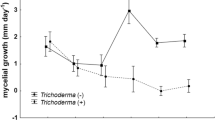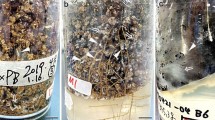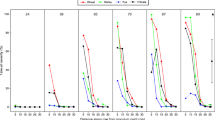Abstract
The mycoparasitic interactions of Verticillium biguttatum with Rhizoctonia solani and with a variety of other soil-borne fungi were investigated in dual cultures. V. biguttatum interacted with various soil fungi by appressed growth along the host hyphae and infrequent penetrations. Intracellular growth and subsequent sporulation, however, only occurred with R. solani, a few binucleate Rhizoctonia and Ceratobasidium spp., and Sclerotinia sclerotiorum. Effective mycoparasitism on sclerotia was restricted to those belonging to R. solani.
Electron-microscopic observations revealed that V. biguttatum can penetrate the host cell with infection tubes. This process is probably mediated by enzymatic hydrolysis of the cell wall. Subsequently, trophic hyphae develop within the host cytoplasm, ultimately resulting in death of the host cell.
Similar content being viewed by others
References
Adams PB & Ayers WA (1983) Histological and physiological aspects of infection of sclerotia of two Sclerotinia species by two mycoparasites. Phytopathology 73: 1072–1076
Boogert PHJF van den (1988) Colonization of roots and stolons of potato plants by the mycoparasite Verticillium biguttatum. Soil Biol. Biochem. (in press)
Boogert PHJF van den & Gams W (1988) Semi-quantitative assessment of Verticillium biguttatum in agricultural soils. Soil Biol. Biochem. 20: 899–905
Boogert PHJF van den & Jager G (1983) Accumulation of hyperparasites of Rhizoctonia solani by addition of live mycelium of R. solani to soil. Neth. J. Plant Pathol. 89: 223–228
Boogert PHJF van den & Jager G (1984) Biological control of Rhizoctonia solani on potatoes by antagonists. 3. Inoculation of seed potatoes with different fungi. Neth. J. Plant Pathol. 90: 117–126
Boosalis MG (1956) Effect of soil temperature and green-manure amendment of unsterilized soil on parasitism of Rhizoctonia solani by Penicillium vermiculatum and Trichoderma sp. Phytopathology 46: 473–478
Elad Y, Barak R & Chet I (1984) Parasitism of sclerotia of Sclerotium rolfsii by Trichoderma harzianum. Soil Biol. Biochem. 16: 381–386
Elad Y, Barak R, Chet I & Henis Y (1983a) Ultrastructural studies of the interaction between Trichoderma spp. and plant pathogenic fungi. Phytopathol. Z. 107: 168–175
Elad Y, Chet I & Henis Y (1982) Degradation of plant pathogenic fungi by Trichoderma harzianum. Can. J. Microbiol. 28: 719–725
Elad Y, Chet I, Boyle P & Henis Y (1983b) Parasitism of Trichoderma spp. on Rhizoctonia solani and Sclerotium rolfsii-Scanning electron microscopy and fluorescence microscopy. Phytopathology 73: 85–88
Hadar Y, Chet I & Henis Y (1979) Biological control of Rhizoctonia solani damping-off with wheat bran culture of Trichoderma harzianum. Phytopathology 69: 64–68
Hänssler G, Hermanns M & Reisener HJ (1982) Elektronenmikroskopische Beobachtungen der Interaktion zwischen Uredosporen von Puccinia graminis var. tritici und Verticillium lecanii. Phytopathol. Z. 103: 139–148
Hawksworth DL (1981) A survey of the fungicolous conidial fungi. In: Cole CT & Kendrick B (Eds) Biology of Conidial Fungi. 1. (pp 171–244) Academic Press, London
Jager G & Velvis H (1985) Biological control of Rhizoctonia solani on potatoes by antagonists. 4. Inoculation of seed tubers with Verticillium biguttatum and other antagonists in field experiments. Neth. J. Plant Pathol. 91: 49–63
Jager G & Velvis H (1986) Biological control of Rhizoctonia solani on potatoes by antagonists. 5. The effectiveness of three isolates of Verticillium biguttatum as inoculum for seed tubers and of a soil treatment with a low dosage of pencycuron. Neth. J. Plant Pathol. 92: 231–238
Jones D, Gordon AH & Bacon JSD (1974) Cooperative action by endo- and exo-β-(1,3)-glucanase from parasitic fungi in the degradation of cell wall glucans of Sclerotinia sclerotiorum. Biochem. J. 140: 47–55
Kuter GA (1984) Hyphal interactions between Rhizoctonia solani and some Verticillium species. Mycologia 76: 936–940
Lewis JA & Papavizas GC (1987) Permeability changes in hyphae of Rhizoctonia solani induced by germling preparations of Trichoderma and Gliocladium. Phytopathology 77: 699–703
Naiki T (1986) Differences in susceptibility of sclerotia of Rhizoctonia solani Kühn to Trichoderma sp. Soil Biol. Biochem. 18: 551–553
Nordbring-Hertz B, Veenhuis M & Harder W (1984) Dialysis membrane technique for ultrastructural studies of microbial interactions. Appl. Environ. Microbiol. 47: 195–197
Pachenari A & NJ Dix (1980) Production of toxins and cell wall degrading enzymes by Gliocladium roseum. Trans. Br. Mycol. Soc. 74: 561–566
Persson Y, Veenhuis M & Nordbring-Hertz B (1985) Morphogenesis and significance of hyphal coiling by nemato-trapping fungi in mycoparasitic relationships. Microb. Ecology 31: 283–291
Traquair JA & McKeen WE (1978) Necrotrophic mycoparasitism of Ceratocystis fimbriata by Horschioporus pargamenus (Polyporaceae). Can. J. Microbiol. 24: 869–874
Tu TC (1980) Gliocladium virens, a destructive mycoparasite of Sclerotinia sclerotiorum. Phytopathology 70: 670–674
Velvis H & Jager G (1983) Biological control of Rhizoctonia solani on potatoes by antagonists. 1. Preliminary experiments with Verticillium biguttatum, a sclerotium-inhabiting fungus. Neth. J. Plant Pathol. 89: 113–123
Velvis H, Boogert PHJF van den & Jager G (1988) The role of antagonism in the decline of Rhizoctonia solani in soil. Soil Biol. Biochem. (in press)
Author information
Authors and Affiliations
Rights and permissions
About this article
Cite this article
van den Boogert, P.H.J.F., Reinartz, H., Sjollema, K.A. et al. Microscopic observations on the interaction of the mycoparasite Verticillium biguttatum with Rhizoctonia solani and other soil-borne fungi. Antonie van Leeuwenhoek 56, 161–174 (1989). https://doi.org/10.1007/BF00399979
Received:
Accepted:
Issue Date:
DOI: https://doi.org/10.1007/BF00399979




